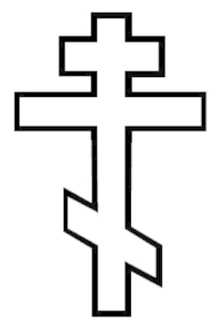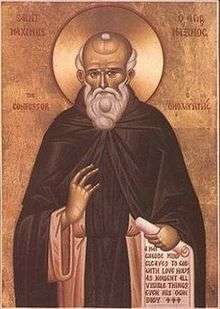January 31 (Eastern Orthodox liturgics)
January 30 - Eastern Orthodox liturgical calendar - February 1
All fixed commemorations below are observed on February 13 by Eastern Orthodox Churches on the Old Calendar.[note 1]
For January 31st, Orthodox Churches on the Old Calendar commemorate the Saints listed on January 18.
Saints
- Martyr Tryphaena of Cyzicus (1st century)[1][2][3][4]
- Martyrs Victorinus, Victor, Nicephorus, Claudius, Diodorus, Serapion, and Papias, at Corinth (251 or 258)[1][3][5][6]
- Holy Wonderworkers and Unmercenaries Cyrus and John,[7][8] and Martyrs Athanasia and her daughters Theoctista, Theodota, and Eudoxia, at Canopus in Egypt (311)[1][3][9][10]
- Martyrs Saturninus, Thyrsus and Victor, at Alexandria.[11]
- Martyrs Tharsicius, Zoticus, Cyriacus, and their companions, at Alexandaria.[12]
- Saint Julius of Aegina (Julius of Novara), missionary priest to northern Italy (401)[13][14][note 2]
- Saint Athanasius, Bishop of Methone (ca. 880)[1][16][note 3]
Pre-Schism Western saints
- Saint Geminian of Modena, Deacon and later successor of the Bishop of Modena (348)[15][note 4]
- Saint Marcella of Rome (410)[1][14][15][16][note 5]
- Saint Madoes (Madianus), a saint who has left his name to a place in the Carse of Gowrie in Scotland.[15]
- Saint Áedan (Maedoc), first Bishop of Ferns in Co. Wexford in Ireland, where he also founded and became abbot of a monastery (626)[15][note 6]
- Saint Adamnan, born in Ireland, he became a monk at Coldingham, now in Scotland (681)[15]
- Saint Wilgils, father of St Willibrord, born in Northumbria in England, he settled on the banks of the River Humber and lived as a hermit (ca. 700)[15][17]
- Saint Bobinus, monk at Moutier-la-Celle. Later he became Bishop of Troyes (ca. 766)[15]
- Saint Ulphia (Wulfia, Olfe, Wulfe), hermitess near Amiens in France (8th century)[15]
- Saint Eusebius, monk at St Gall in Switzerland and later lived as a hermit on Mt St Victor in the Vorarlberg (884)[15][note 7]
- Saint John Angelus, born in Venice in Italy, he became a monk at Pomposa (ca. 1050)[15]
Post-Schism Orthodox saints
Other commemorations
- Synaxis of the Icon of the Most Holy Theotokos Koroniotissa or Dakryrroousis, at Lixouri, Cephalonia (1867)[23]
- Repose of Eugene Poselyanin (Pogozhev), spiritual writer (1931)[1]
- Repose of Elder Codratus (Condratus) of Karakalou monastery, Mt. Athos (1940)[1]
- Repose of Hieroschemamonk Stephen (Ignatenko) of Kislovodsk (1973)[1]
- Martyrdom of Paul (de Ballester-Convallier), Bishop of Nazianzus, in Mexico City (1984)[24]
Icon gallery
.jpg) Martyr Tryphaena of Cyzicus.
Martyr Tryphaena of Cyzicus.
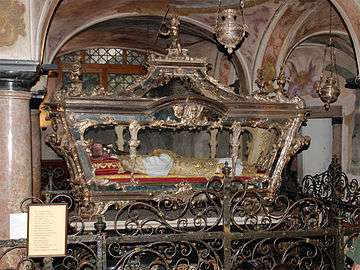 Relics of Saint Julius of Aegina (Julius of Novara).
Relics of Saint Julius of Aegina (Julius of Novara).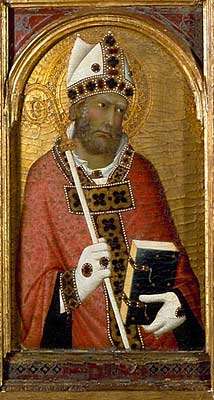 St. Saint Geminian of Modena.
St. Saint Geminian of Modena.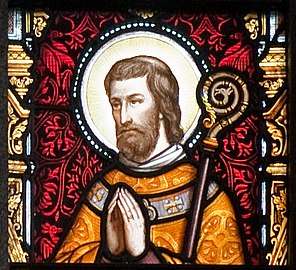 Saint Áedan (Maedoc), stained glass window in Enniscorthy Cathedral.
Saint Áedan (Maedoc), stained glass window in Enniscorthy Cathedral. Bas relief of Ulphia in a chapel at the cathedral of Amiens.
Bas relief of Ulphia in a chapel at the cathedral of Amiens. Venerable Nikita of Novgorod.
Venerable Nikita of Novgorod._Estado_Mexico_(3377720656).jpg) Monument to Bp. Paul of Nazianzus in Naucalpan, Mexico.
Monument to Bp. Paul of Nazianzus in Naucalpan, Mexico.
Notes
- The notation Old Style or (OS) is sometimes used to indicate a date in the Julian Calendar (which is used by churches on the "Old Calendar").
The notation New Style or (NS), indicates a date in the Revised Julian calendar (which is used by churches on the "New Calendar"). - Julius was a priest and his brother Julian a deacon. Together they converted heathen temples into Christian churches.[15]
- Saint Athanasius was born in Catania in Sicily, during the invasion of the Saracens he fled to Patras in Greece, where he became a monk and eventually a bishop (ca. 885)[15]
- He gave refuge to St Athanasius the Great when he came through Italy on his way to exile in Gaul. Geminian bravely opposed Jovinianism.
- A noblewoman of Rome, as a widow she turned her home into a house-church and she devoted herself to prayer and almsgiving. When Alaric sacked Rome, Marcella was cruelly scourged as the Goths thought that she had hidden her wealth. In reality she had already distributed it to the poor. She died shortly after from the effects of this treatment.
- "MAEDOC, who is also called AIDUS or AIDAN, and in English Hugh, belonged to an illustrous family in Ireland. He was granted to the prayers of his parents, who had lived for a length of time without children. The early piety of Maedoc attracted attention, and even then a number of youths desired to place themselves under his guidance. To escape those tokens of respect, he fled from his own country and took refuge with St. David at his monastery in Wales. In that retreat he was trained in the practices of the religious life, and gave evidence of his sanctity by various miracles, which he performed. With the blessing of his holy master he returned to Ireland, founded several religious houses, and was consecrated Bishop of Ferns. It was in his episcopal See that he gave up his soul to God."[17]
- While denouncing godlessness, he was struck with a scythe and killed. As a result he was venerated as a martyr.
gollark: UDP is just for sending small packets.
gollark: Nope. It runs over TCP.
gollark: Better than what? For what?
gollark: I don't see why you would want to stuff your entire request body in headers when there's a perfectly good request body system.
gollark: Primarily that some things won't be happy with it because nobody does it. Other than that:- servers may allocate limited-sized buffers for incoming request headers so you can't put too much in them (this is somewhat problematic for cookies)- headers have character set limits while bodies can be arbitrary bytes- request bodies are generated by forms and all sane clients so stuff is mostly designed to deal with those- request bodies can probably be handled more performantly because of stuff like the length field on them
References
- January 31 / February 13. Orthodox Calendar (PRAVOSLAVIE.RU).
- Great Synaxaristes: (in Greek) Ἡ Ἁγία Τρύφαινα ἡ Μάρτυς. 31 Ιανουαρίου. ΜΕΓΑΣ ΣΥΝΑΞΑΡΙΣΤΗΣ.
- (in Greek) Συναξαριστής. 31 Ιανουαρίου. ECCLESIA.GR. (H ΕΚΚΛΗΣΙΑ ΤΗΣ ΕΛΛΑΔΟΣ).
- Martyr Tryphaina at Cyzicus. OCA - Lives of the Saints.
- Great Synaxaristes: (in Greek) Οἱ Ἅγιοι Οὐϊκτωρίνος, Οὐΐκτωρ, Νικηφόρος, Κλαύδιος, Διόδωρος, Σαραπίνος καὶ Παπίας οἱ Μάρτυρες ἐν Κορίνθῳ. 31 Ιανουαρίου. ΜΕΓΑΣ ΣΥΝΑΞΑΡΙΣΤΗΣ.
- Martyr Victorinus of Egypt. OCA - Lives of the Saints.
- Wonderworker and Unmercenary Cyrus. OCA - Lives of the Saints.
- Wonderworker and Unmercenary John. OCA - Lives of the Saints.
- Great Synaxaristes: (in Greek) Οἱ Ἅγιοι Κύρος καὶ Ἰωάννης οἱ Θαυματουργοί Ἀνάργυροι καὶ οἱ σὺν αὐτοῖς Ἀθανασία, Θεοδότη, Θεοκτίστη καὶ Εὐδοξία οἱ Μάρτυρες. 31 Ιανουαρίου. ΜΕΓΑΣ ΣΥΝΑΞΑΡΙΣΤΗΣ.
- Martyr Athanasia and her daughters at Canopus in Egypt. OCA - Lives of the Saints.
- Great Synaxaristes: (in Greek) Οἱ Ἅγιοι Σατουρνίνος, Θύρσος καὶ Βίκτωρ οἱ Μάρτυρες. 31 Ιανουαρίου. ΜΕΓΑΣ ΣΥΝΑΞΑΡΙΣΤΗΣ.
- Great Synaxaristes: (in Greek) Οἱ Ἅγιοι Ταρσίζιος, Ζωτικός, Κυριακὸς καὶ Σώκιος οἱ Μάρτυρες. 31 Ιανουαρίου. ΜΕΓΑΣ ΣΥΝΑΞΑΡΙΣΤΗΣ.
- Great Synaxaristes: (in Greek) Ὁ Ἅγιος Ἰούλιος ὁ Πρεσβύτερος ἐξ Αἰγίνης. 31 Ιανουαρίου. ΜΕΓΑΣ ΣΥΝΑΞΑΡΙΣΤΗΣ.
- The Roman Martyrology. Transl. by the Archbishop of Baltimore. Last Edition, According to the Copy Printed at Rome in 1914. Revised Edition, with the Imprimatur of His Eminence Cardinal Gibbons. Baltimore: John Murphy Company, 1916. pp. 32–33.
- January 31. Latin Saints of the Orthodox Patriarchate of Rome.
- February 13 / January 31. HOLY TRINITY RUSSIAN ORTHODOX CHURCH (A parish of the Patriarchate of Moscow).
- Rev. Richard Stanton. A Menology of England and Wales, or, Brief Memorials of the Ancient British and English Saints Arranged According to the Calendar, Together with the Martyrs of the 16th and 17th Centuries. London: Burns & Oates, 1892. pp. 42-43.
- Great Synaxaristes: (in Greek) Ὁ Ὅσιος Νικήτας ἐκ Κιέβου. 31 Ιανουαρίου. ΜΕΓΑΣ ΣΥΝΑΞΑΡΙΣΤΗΣ.
- Venerable Nikita of the Kiev Caves, Far Caves the Bishop of Novgorod. OCA - Lives of the Saints.
- Great Synaxaristes: (in Greek) Ὁ Ἅγιος Ἠλίας ὁ Νέος Ὁσιομάρτυρας τοῦ Ἀρδούνη. 31 Ιανουαρίου. ΜΕΓΑΣ ΣΥΝΑΞΑΡΙΣΤΗΣ.
- Great Synaxaristes: (in Greek) Ὁ Ὅσιος Ἀρσένιος ὁ ἐν Πάρῳ. 31 Ιανουαρίου. ΜΕΓΑΣ ΣΥΝΑΞΑΡΙΣΤΗΣ.
- St Arsenius of Paros. OCA - Lives of the Saints.
- Great Synaxaristes: (in Greek) Σύναξις Ὑπεραγίας Θεοτόκου τῆς Κορωνιωτίσσης ἢ Δακρυρροούσης. 31 Ιανουαρίου. ΜΕΓΑΣ ΣΥΝΑΞΑΡΙΣΤΗΣ.
- "Biografía del Doctor Pablo de Ballester". Asociación Cultural Santorini (in Spanish). Retrieved 7 February 2018.
Sources
- January 31 / February 13. Orthodox Calendar (PRAVOSLAVIE.RU).
- February 13 / January 31. HOLY TRINITY RUSSIAN ORTHODOX CHURCH (A parish of the Patriarchate of Moscow).
- January 31. OCA - The Lives of the Saints.
- The Autonomous Orthodox Metropolia of Western Europe and the Americas (ROCOR). St. Hilarion Calendar of Saints for the year of our Lord 2004. St. Hilarion Press (Austin, TX). p. 11.
- January 31. Latin Saints of the Orthodox Patriarchate of Rome.
- The Roman Martyrology. Transl. by the Archbishop of Baltimore. Last Edition, According to the Copy Printed at Rome in 1914. Revised Edition, with the Imprimatur of His Eminence Cardinal Gibbons. Baltimore: John Murphy Company, 1916. pp. 32–33.
- Rev. Richard Stanton. A Menology of England and Wales, or, Brief Memorials of the Ancient British and English Saints Arranged According to the Calendar, Together with the Martyrs of the 16th and 17th Centuries. London: Burns & Oates, 1892. pp. 42–43.
Greek Sources
- Great Synaxaristes: (in Greek) 31 ΙΑΝΟΥΑΡΙΟΥ. ΜΕΓΑΣ ΣΥΝΑΞΑΡΙΣΤΗΣ.
- (in Greek) Συναξαριστής. 31 Ιανουαρίου. ECCLESIA.GR. (H ΕΚΚΛΗΣΙΑ ΤΗΣ ΕΛΛΑΔΟΣ).
Russian Sources
- (in Russian) 13 февраля (31 января). Православная Энциклопедия под редакцией Патриарха Московского и всея Руси Кирилла (электронная версия). (Orthodox Encyclopedia - Pravenc.ru).
- (in Russian) 31 января (ст.ст.) 13 февраля 2013 (нов. ст.). Русская Православная Церковь Отдел внешних церковных связей. (DECR).
This article is issued from Wikipedia. The text is licensed under Creative Commons - Attribution - Sharealike. Additional terms may apply for the media files.
